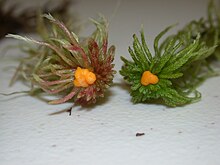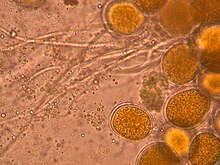Endogone
| Endogone | |
|---|---|
 |
|
| A sporocarp of Endogone pisiformis | |
 |
|
| Double-walled zygospores of E. pisiformis | |
| Scientific classification | |
| Kingdom: | Fungi |
| Division: | Zygomycota |
| Subdivision: | Mucoromycotina |
| Order: | Endogonales |
| Family: | Endogonaceae |
| Genus: |
Endogone Link (1809) |
| Type species | |
|
Endogone pisiformis Link (1809) |
|
| Species | |
|
~25, see text |
|
~25, see text
Endogone is a genus of fungi in the family Endogonaceae of the class Zygomycota. The genus has a widespread distribution, especially in temperate regions, and contains about 20 species.
Species of Endogone form underground structures called sporocarps—fruiting structures measuring between a few millimeters to 2–3 cm (0.8–1.2 in) in diameter, containing densely interwoven hyphae and zygospores. Sporocarps are typically found in humus-rich soil or leaf mold, or in mosses. Although most species will only produce spores in nature, the type species E. pisiformis can be made to sporulate in test tube culture when grown with conifer seedlings.
Endogone was first circumscribed by Johann Heinrich Friedrich Link in an 1809 publication. In 1922, Roland Thaxter revised the taxonomy of the family Endogonaceae, recognizing four genera: Endogone, Sphaerocreas, Sclerocystis, and Glaziella. In 1935, Herbert Zycha transferred the sole species of Sphaerocreas recognized by Thaxter to Endogone. In their 1974 monograph of the Endogonaceae, James Gerdemann and James Trappe deviated from Thaxter’s concept of Endogone, which contained taxa with chlamydospores and zygospores, including only those species that formed zygospores in sporocarps. In the mid-1990s, Yi-Jian Yao and colleagues further restricted Endogone to those species that produced suspensors that were in contact with one another along the entire length. Those taxa in which the suspensors did not touch one another were transferred to a new genus, Youngiomyces.
...
Wikipedia
